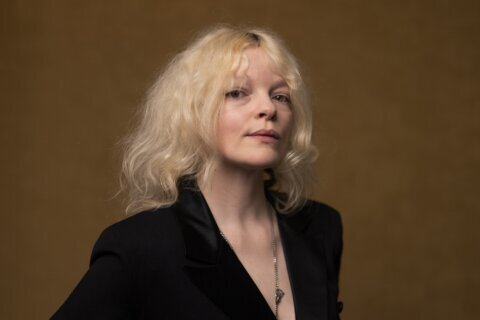WASHINGTON — “You don’t understand! I coulda had class, I coulda been a contender, I coulda been somebody, instead of a bum, which is what I am. … It was you, Charlie.”
Few movies are as iconic as “On the Waterfront” (1954), winner of a whopping eight Academy Awards, including Best Picture, Best Director (Elia Kazan) and Best Actor (Marlon Brando).
This Saturday, the National Philharmonic presents the film at Strathmore with live orchestral accompaniment conducted by composer Leonard Bernstein’s own protégé Piotr Gajewski.
“My job will be to do the music live as the picture is being shown, so I have to be intimately familiar with exactly how it fits in,” Gajewski told WTOP. “I’ve been watching it and watching it and I’ve probably now seen it I’m guessing between 20 and 30 times — and then some.”
Written by Bud Schulberg after a first draft by Arthur Miller, the film follows ex-prize fighter Terry Malloy (Marlon Brando) who works as a longshoreman in New Jersey, clashing with corrupt union boss Johnny Friendley (Lee J. Cobb), arguing with brother Charlie (Rod Steiger), confiding in a priest (Karl Malden) and falling for a victim’s sister Edie Doyle (Eva Marie Saint).
“People who go to the movies and cry don’t realize it’s actually the soundtrack underneath that gets you to that point,” Gajewski said. “If you were to take out the soundtrack, you don’t get there. It’s the music that makes it happen. Frankly, it’s us musicians who hold the key. We kind of know what it is, the timing of things. We have magic dust that we throw on things.”
Gajewski actually trained under Bernstein at the Tanglewood Music Center in Massachusetts.
“The older I get, the fewer there are of us who can say that,” Gajewski said. “Conductors of our generation, that was the thing! … Bernstein was in the program the very first year [and] he would come back to teach. That was my lucky moment in 1983. I was 24 years old. He was in his 60s and a legend at that point. … We actually conducted on the same concert!”
What does he remember about the man behind the myth?
“He was crazy in so many wonderful ways,” Gajewski said. “He had what we would call today ‘no filters.’ Whatever was in his brain came out. … It totally didn’t matter what you thought of him. … For a conductor, it happens to be a wonderful quality. Conductors are put in front of 100 musicians. … You just have to be yourself. And he was himself all the time to the max.”
While his Broadway music carried over to films like “West Side Story” (1961), “On the Waterfront” remains the only original score that Bernstein wrote directly for the screen.
“It was his first crack at films and he never went back,” Gajewski said. “He got frustrated by the experience. For a composer of that stature, you’re subservient to the director and the studio. You have the length, they tell you to make cuts that you don’t want to make. His career moved forward and he didn’t look back, but it’s great they got him because at least we have this.”
The one-and-done scenario allowed Bernstein to experiment musically.
“He was coming to it completely fresh and he was an innovator,” Gajewski said. “So, rather than doing the standard stuff like starting with a big orchestral thing, he just starts the score with a single instrument, [a horn], evoking the loneliness and nobility of the whole thing.”
Then, like a ship crashing into the docks, the percussion kicks in.
“He actually uses two sets of timpani, so when you do it live, you can set them apart and hear it from different directions, so there’s an interplay,” Gajewski said. “Then he uses saxophones to evoke the time and the place. It’s a very interesting score. … It gets really wild up until the moment somebody falls off the roof, then suddenly silence and suddenly the story begins.”
The American Film Institute voted “On the Waterfront” among the Top 25 movie scores ever.
“What Bernstein does is he writes themes for various characters and various aspects of the film, leit motifs,” Gajewski said. “Toward the end of the film, he superimposes them as things come together, then the final scene there’s this march to the end that builds triumphantly.”
Those characters are brought to life by a stellar cast. Not only do we get Saint in her debut role, we also get Brando reuniting with Kazan after “A Streetcar Named Desire” (1951).
“They had to convince Brando to take the part,” Gajewski said. “They considered Elizabeth Montgomery for [Saint’s part]. Grace Kelly was also considered, but she decided to do ‘Rear Window’ instead. Frank Sinatra wanted the priest role but they gave it to Karl Malden, who originally wanted the principal role, but that went away, so then he wanted the priest role.”
If such movie history is your passion, show up early at 6:45 p.m. for a pre-show panel with associate conductor Victoria Gau and film buffs Linda DeLibero of Johns Hopkins University and David Sterritt of the Maryland Institute College of Art. The screening starts at 8 p.m.
“It’s in Strathmore, it’s one of the best films of all time and it’s on a very large screen, it’s remastered and the music is live,” Gajewski said. “If you’ve never heard it before that way, you owe it to yourself. It’s the greatest score and the greatest experience.”
Find more details on the Strathmore website. Hear our full chat with Piotr Gajewski below:







